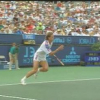Free Online Productivity Tools
i2Speak
i2Symbol
i2OCR
iTex2Img
iWeb2Print
iWeb2Shot
i2Type
iPdf2Split
iPdf2Merge
i2Bopomofo
i2Arabic
i2Style
i2Image
i2PDF
iLatex2Rtf
Sci2ools
112
Voted
ICIP
2004
IEEE
2004
IEEE
An efficient content-adaptive MC 3D-DWT with enhanced spatial and temporal scalability
In this paper we propose a novel, adaptive method for motion compensated 3D wavelet transformation (MC 3D-DWT) of video. The proposed method overcomes problems of ghosting and non-aligned aliasing artifacts which can arise in regions of motion model failure, when the video is reconstructed at reduced temporal or spatial resolutions. Previous MC 3D-DWT structures either take the form of a MC temporal DWT followed by a spatial transform ("t+2D"), or perform the spatial transform rst, limiting the spatial frequencies which can be jointly compensated in the temporal transform, and hence limiting the compression efciency. Essentially, the proposed transform continuously adapts itself between these two extremes, based on information available within the compressed bit-stream. Experimental results indicate that the proposed adaptive transform signicantly reduces the cost in compression efciency required to achieve high quality spatial and temporal scalability.
Adaptive Transform | ICIP 2004 | Image Processing | Mc Temporal Dwt | Spatial Resolutions | Spatial Transform Rst | Temporal Transform |
| Added | 24 Oct 2009 |
| Updated | 27 Oct 2009 |
| Type | Conference |
| Year | 2004 |
| Where | ICIP |
| Authors | Nagita Mehrseresht, David Taubman |
Comments (0)

